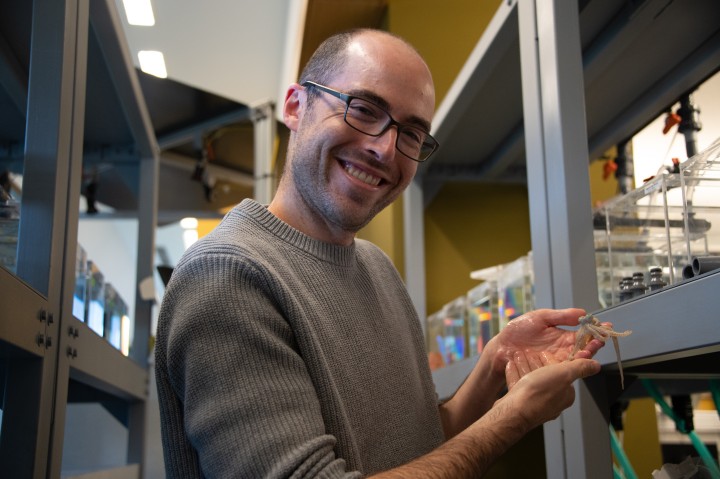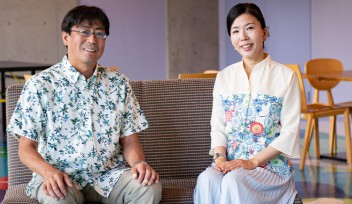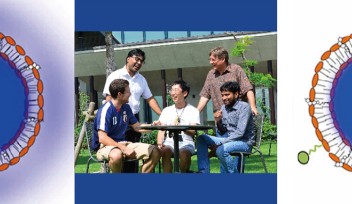Four challenging OIST research projects selected for FOREST (Fusion Oriented REsearch for disruptive Science and Technology) program
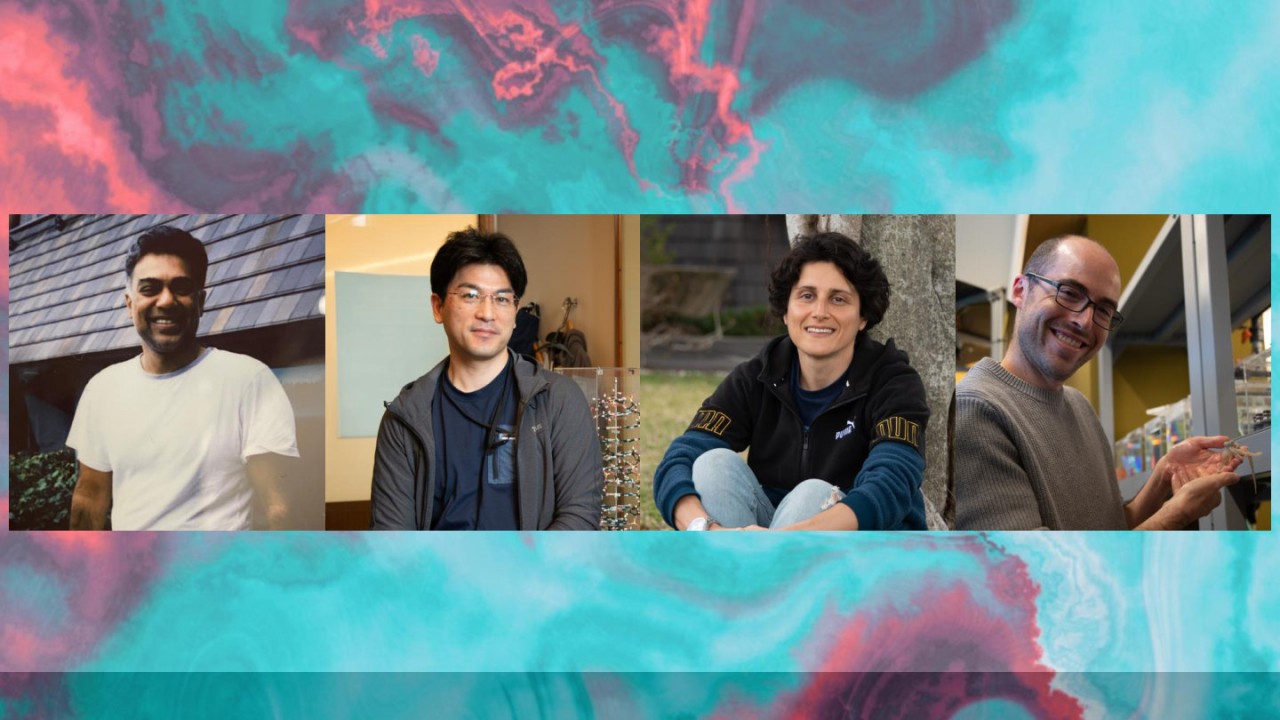
The Japan Science and Technology Agency (JST) has selected four research projects by OIST researchers for the “Fusion Oriented REsearch for disruptive Science and Technology (FOREST)" program for fiscal year 2022.
This program provides long-term (7 years in principle and up to 10 years) support for unrestricted, challenging, and fusion-oriented research that could lead to disruptive innovation, with a maximum research budget of 50 million yen. This year, 2,790 applications were received from across Japan, and 263 projects and principal investigators were selected.
Inspired by the mystery of the emergence of life - Assistant Professor Tomomi Kiyomitsu
Assistant Professor Tomomi Kiyomitsu, who leads the Cell Division Dynamics Unit, has been selected for a research project focusing on early embryonic division, the initial stage of cell division that takes place shortly after fertilization.
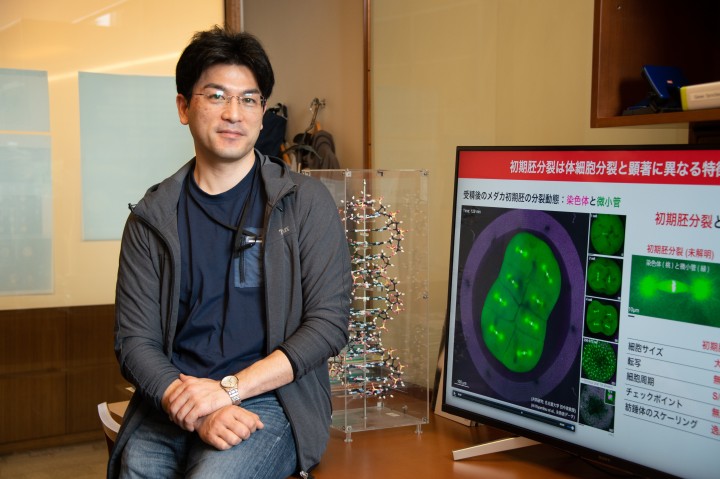
While much is known about the mechanism of somatic cell division, a process of creating the body, a large part of the mechanism of the preceding phase called early embryonic division remains unknown. Prof. Kiyomitsu explains, "The mechanism of early embryonic division is completely different from that of somatic cell division. Its unexpected functions still continue to surprise us. The early embryo is like a treasure trove of research."
Cell division is the process by which a cell divides. In other words, one cell (parent cell) splits to make two new cells (daughter cells). It is a growth mechanism common to all organisms. During cell division, chromosomes must also be equally distributed between the two daughter cells, which is achieved by a structure called the spindle.
Prof. Kiyomitsu explained, "Cell division in the early embryo proceeds incredibly fast with extreme precision. It goes through a complex process that involves chromosome capture and distribution in a very short period of time. However, how the spindle of the early embryo controls cell division, and what genes and substances are involved in the process, are still shrouded in mystery."
To find the answers to these questions, Prof. Kiyomitsu will establish a new experimental method to study the mechanism of early embryonic division using killifish, which have similar genes to humans.
At OIST, a new facility has been installed specifically for killifish breeding, and the project is already underway.
"Over the next seven years, we would like to take our time and boldly take on a variety of challenges. We are also looking for new team members who will join us on our adventures," said Prof. Kiyomitsu with enthusiasm.
This research not only pursues a fundamental mystery of life, but also has the possibility to produce findings that can be useful for infertility treatment. "It is said that early embryos have some kind of mechanism that removes abnormal cells, but the details are still unknown. By uncovering such potentials of early embryos and exploring other unexpected phenomena, we hope to make new discoveries related to fertility treatment."
Unlocking the secrets of plant survival strategies carved into mangrove DNA – Dr. Matin Miryeganeh
Dr. Matin Miryeganeh, a staff scientist in the Integrative Community Ecology Unit, has been selected for her research on mangroves, that aims to reveal how plants cope with environmental stresses such as climate change, with a focus on the "epigenome."
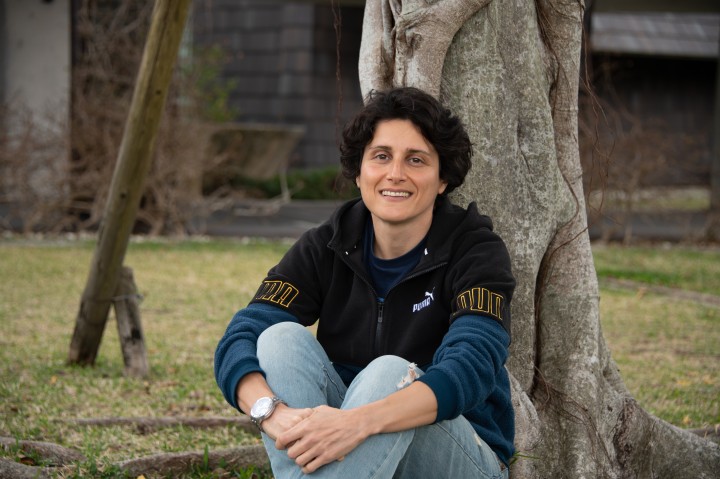
Organisms typically have thousands of genes, but whether these genes are active or inactive at different times or in different tissues is determined by the epigenome. The epigenome refers to all the modifications that are made to the genome that don’t alter the underlying gene sequences, only how they are expressed. These epigenetic changes, which are made to DNA and associated proteins in the chromosome, vary depending on stress and external stimuli.
Dr. Miryeganeh highlighted the appeal of her study on survival strategies of plants by saying, "Animals can move around to find a comfortable environment for themselves, but it is not easy for plants to do so. Instead, they rely on epigenetic changes to adapt to their environment and survive. The study of epigenomics may be like the so-called behavioral science of plants."
When asked why she chose mangroves for her plant epigenome research, Dr. Miryeganeh answered, "Mangroves grow in the areas where there are many stress factors on a daily basis that normal plants are not exposed to, such as high salinity, the degree of which varies daily because of tidal changes. I am focusing on the resilience of mangroves that allows them to survive in such an environment. By establishing an epigenomic research method using mangroves as a model, I hope to understand the general epigenomic survival strategies of plants."
She adds: "generally, individuals of a population that express genes related to stress-tolerance can cope better with environmental extremes, survive longer, and have more offspring. This means that over time, specific stress-tolerance traits encoded in their DNA may be preserved through natural selection. However, selection requires time, and the ongoing rapid pace of climate change makes it difficult for plants to keep up with the change and adapt fast enough before they undergo irreversible damages. This is where epigenetic regulation, may come to rescue."
Dr. Miryeganeh has great hope that much can be learned from the rich mangrove forests of Okinawa. She said, "We still don't know much about how efficiently plants have adapted to environmental stresses and have undergone epigenetic changes, or how their epigenome has been passed from one generation to the next. If we can unravel this mystery, we may be able to develop agricultural products that are resilient to rapid climate change. I believe that our research in mangroves in Okinawa will provide new insights in this direction."
“I am very honored that my project has been selected for the FOREST program, which gives me the opportunity to focus on long-term deep research without distraction of time and financial shortage, and will hopefully lead me to become a better and independent scientist. I have high hopes for this project and look forward to producing results that will lead to many discoveries and unfold more layers revealing the extraordinary resilience of mangroves.”
Exploring the infinite "invisible" possibilities - Associate Professor Keshav Dani
Associate Professor Keshav Dani, who leads the Femtosecond Spectroscopy Unit, has been selected for a research project that seeks to utilize "dark excitons" for quantum technology applications using cutting edge instrumentation developed at OIST.
Excitons are excited states of matter found in semiconductors. They form when electrons are excited to a higher energy state by a photon of light, leaving behind a hole at the original energy level. The electron and hole then attract each other, forming a new particle – the exciton, Excitons have been studied for many decades for their applications in semiconductor devices and technologies.
However, in research on excitons to date, scientists largely used light to probe them. This method only allowed them to study the so-called bright excitons – those that have negligible momentum, and thus can interact with light. " Excitons, that possess finite momentum cannot interact with light due to momentum-conservation laws, and hence are called ‘dark excitons. Till recently, researchers had no way to observe them directly, and thus have not been able to take advantage of their strengths in semiconductor devices.
Against this backdrop, Prof. Dani successfully established a groundbreaking method to directly observe dark excitons in 2020. He said, "This is a breakthrough in exciton research, because it gives us a way to directly image dark excitons, and understand how they might be controlled and manipulated."
One of the potential strengths of dark excitons is directly related to the challenge in observing them – their inability to interact with light. Usually, when a quantum particle interacts with light, it can rapidly loose coherence – a property of the quantum state of the particle that’s essential in implementing quantum technology applications, such as quantum computers and quantum communications.. Prof. Dani said, "In principle, the inability of dark excitons to interact with light also provides them some degree of protection from decoherence. So, there are great hopes that dark excitons could provide a robust platform for future quantum technologies that are protected from basic decoherence mechanisms."

Prof. Dani expressed his enthusiasm for this project and his gratitude to the Kawamura Panel of the FOREST Program for their bold vision in seeking to plant ‘seeds leading to disruptive innovation’ by investing in next-generation, long-term research. “I remain grateful to OIST and JST for creating opportunities for scientists like me to pursue our childhood dreams and curiosities in a scientific paradise”
Deep science on "sleep" - Assistant Professor Samuel Reiter
Other project includes Assistant Professor Sam Reiter, who heads the Computational Neuroethology Unit, has been selected for a research project to understand how octopus sleep, and the neural mechanisms that underpin their sleeping behavior.
Prof. Reiter expressed his enthusiasm for the research, saying, "There are many species of octopus living in the seas around Okinawa, and we have been able to conduct our research thanks to the great support from local fishermen. I am very excited to be able to study the unsolved mysteries in Okinawa."
